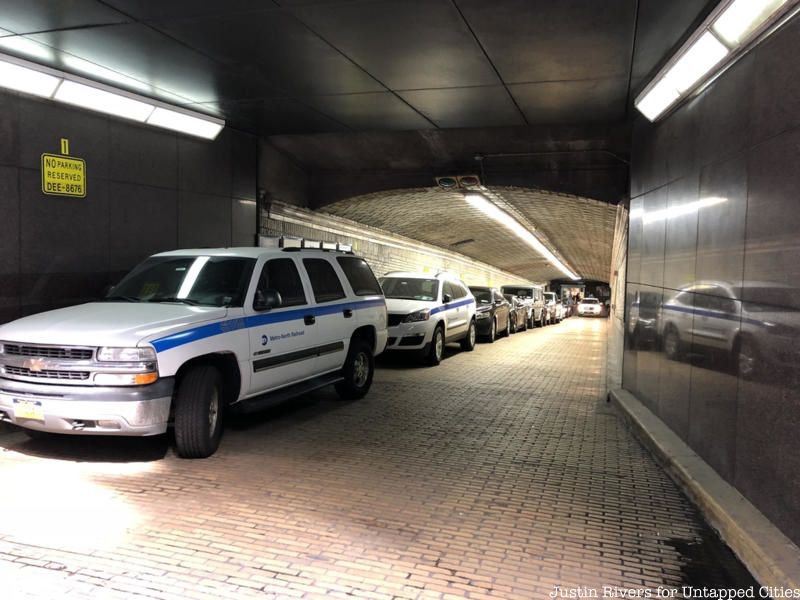Last-Minute NYC Holiday Gift Guide 🎁
We’ve created a holiday gift guide with presents for the intrepid New Yorker that should arrive just in time—


Untapped Cities staff are always on the look out for hidden or unrecognized remnants of New York City’s past. Our tour guide Justin Rivers recently came upon one such remnant inside a parking garage! Noticing the famed arched herringbone pattern typical of Guastavino tile work, just like the famous ceiling of the Grand Central Oyster Bar, he did some digging and found out that this space was once part of The Biltmore Hotel, a grand Whitney Warren and Charles Wetmore designed structure that was built as part of “Terminal City,” a compound of hotels and other buildings connected to Grand Central Terminal that was proposed in the original plans by Charles A. Reed and Allen H. Stem, along with William Wilgus.

Image via Wikimedia Commons, Detroit Publishing Company Collection
It was originally New York Central Railroad engineer William J. Wilgus’ idea to use the air rights above Grand Central’s train yards to generate revenue. Since the Grand Central rail yards were sunken and covered, structures could be built above them. Wilgus envisioned a grand boulevard accompanying the terminal that according to Sam Robert’s book Grand Central: How a Train Station Transformed America, would have “a civic center, opera house, hotels, and office buildings.”
Though Warren and Wetmore wrested the design contract for Grand Central Terminal from Reed & Stem and the original plans for Terminal City would never be fully realized, Grand Central did serve as an “impetus for extraordinary urban renewal,” inspiring the construction of many large buildings along Park Avenue, 42nd Street and Vanderbilt Avenue. By 1926, 15,000 residents and 25,000 workers could reach their offices or homes without ever stepping outside on their commute from the terminal. As Robert’s states in his book, “Grand Central made midtown.” Along with the Chrysler Building, the Yale Club, the Commodore Hotel and other notable addresses that sprung up around the terminal was the luxurious Biltmore Hotel.
[post_featured_tour]
The Biltmore Hotel opened on New Years Day 1913. The H-shaped structure stood 26-stories high and had a neo-classical style. One of the most famous features of the hotel was the golden clock located in the lobby which served as a meeting place for clientele like J.D. Salinger. The Biltmore is where F. Scott and Zelda Fitzgerald honeymooned and where Henry Ford attempted to broker peace before World War I. Inside, the hotel contained one thousand rooms and amenities such as a roof garden, one of the first indoor swimming pools, Turkish baths, and sometimes in the winter, ice-skating on the terrace. The H-shaped design of the hotel made it possible for most rooms to have outside exposure and one of the best amenities was the ease with which guests could come and go using the hotel’s connection to Grand Central Terminal.

In the 1970s, Paul and Seymour Milstein purchased the Biltmore Hotel with the intention of turning it into an office building, since the hotel business was slumping but demand for midtown office space was rising. In 1981, the hotel closed and was quickly striped to its steel frame and redesigned as 335 Madison Avenue. Despite hasty preservation efforts to at least save some interior elements, all of the Biltmore Hotel was lost save it’s iconic golden clock, which can be found in the lobby of 335 Madison Avenue, and a tunnel which can be found in Grand Central terminal and via an entrance on 44th street.

The pathway leading into the tunnel from Grand Central Terminal is not marked. It’s located on the western end of the Terminal, next to the Pylones store and the Transit Museum annex. “The garage also has a sign that erroneously calls Grand Central Terminal, Grand Central Station,” Rivers tells us. The parking garage entrance can be found on 44th street between Vanderbilt and Madison. If you visit the garage at night when no cars are parked in it, you will find various cab stop signs engraved on the ground, spread about eight feet apart from one another. Guests of the Biltmore arriving at Grand Central Terminal could have their luggage collected from the train by porters, travel via tunnel to an elevator in the hotel’s basement and be carried up into the hotel without ever having to step outside.

To uncover more secrets of Grand Central Terminal, join us for an upcoming tour inside the iconic transit hub:
Next, check out 12 Beautiful Locations to Find Guastavino Tiles in NYC and discover Secrets About Grand Central Terminal.
Subscribe to our newsletter